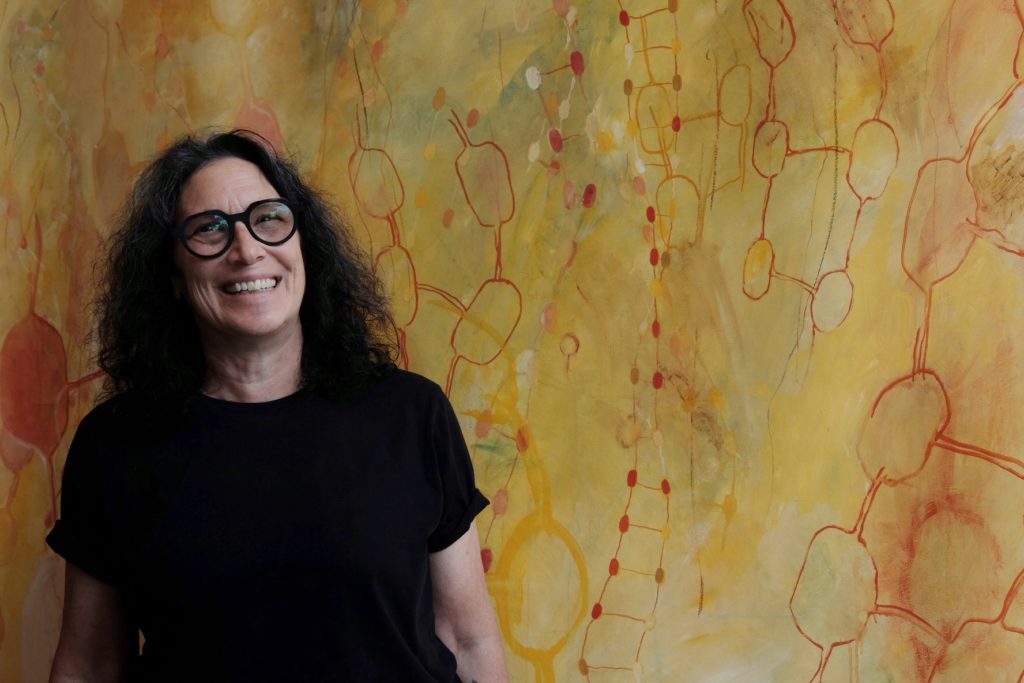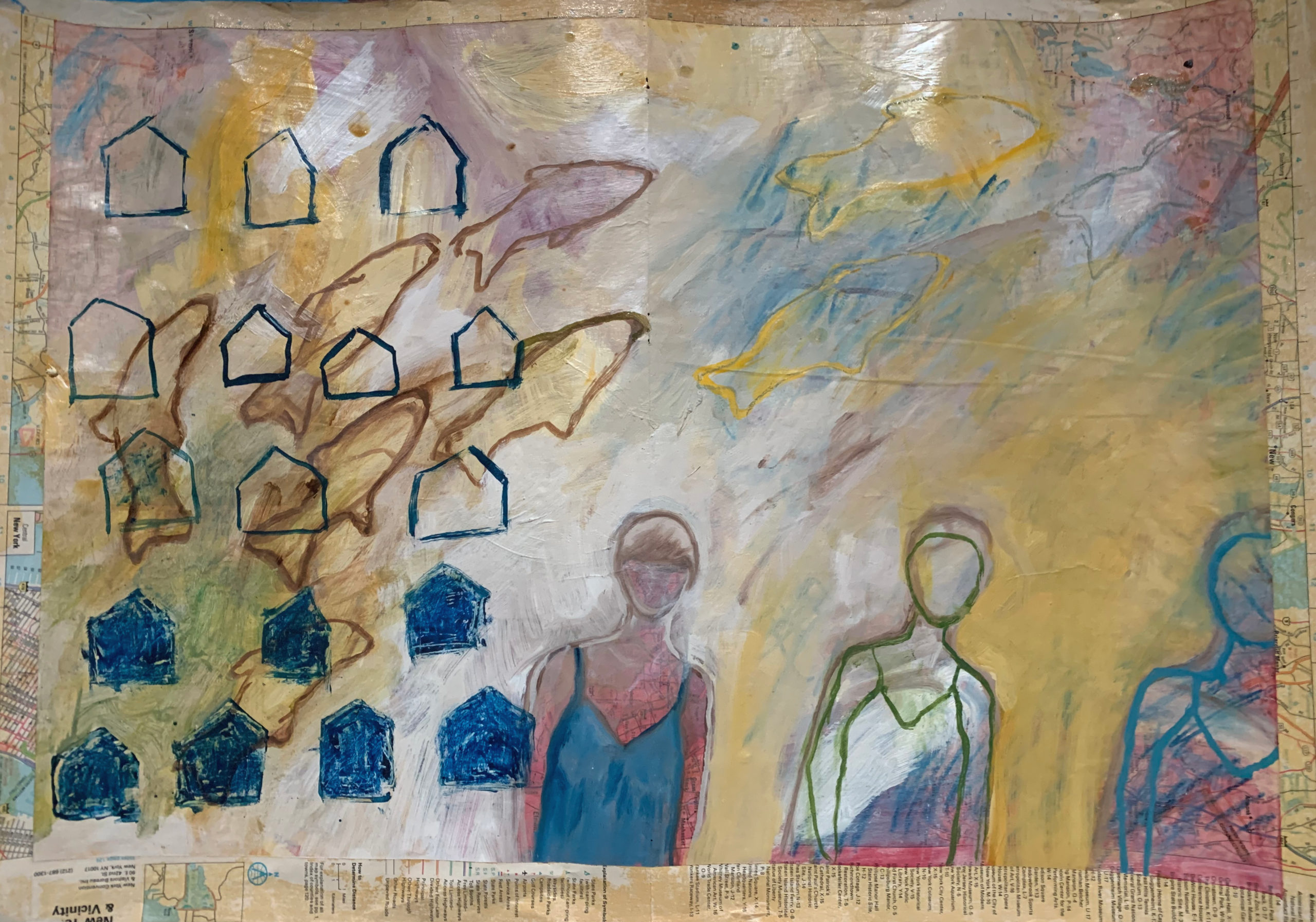The work looks wildly derivative to me, all these years later. My cohort was tight. We worked long hours in the same studio classrooms, we were kind to each other, we connected. For his thesis, one of my classmates did a series of panels, each one an homage to us. I still have the one he made in my style. How can I look at this work all these years later and not see Tim or Karen or Josh or Alison… it’s impossible to ignore them. They are right there.
When the gallery owner asks me to talk about the work to the nice couple eyeing my paintings, this is what I tell them. That I can’t look at the work without seeing my instructors, my classmates. I loved art school, I loved my classmates, but the work feels like theirs. It’s the later work that feels like mine.

The couple earnestly studies three large paintings pinned to the gallery wall. Prystine Ecchevarria runs the space; she’s a dealer, a fixer, a force. I got her name from the woman who’s handling my mom’s jewelry. I had been looking for someone to help find homes for my mom’s art collection. When Prystine came to look at my mom’s collection, she asked about the stuff on my walls. Three weeks later we were unrolling my paintings in the basement, work that hasn’t seen daylight for years.
“You’re insane,” she said, “Why aren’t you painting? Can I show this work? Can I show it this weekend?”
I loved being a working artist. I loved having a studio space and I loved the smell of linseed oil and I loved the physical act of making paintings the size of my reach. I haven’t made art for many years, but I can still feel the resistance of paper tacked to the wall and the dry texture of my hands after hours inside rubber gloves. I must have always carried about me a vague scent of paint thinner and cheap moisturizer.
I had a way with color; those meticulous studies in college paid off. While I have never been good with realism, I draw well enough to represent the things I want to represent. I am handy with patterns and skilled enough to decide if I want those patterns to be flat or if I want them to shift in space. For me, the works are packed with meaning because they were how I thought through what I was dealing with at the time, but they’re not confrontational. I think some of them are quite beautiful, they stand alone without the backstory.

But I did not sell. Well, I did not sell enough. I made a few hundred dollars here and there, enough to pay rent on my studio for a month or maybe three. Enough to restock my supplies. But it was never enough to pay for housing, never enough to give me the time to paint, never enough to make art a top priority. I got a job in tech where I earned enough to buy a tiny condo. I packed up my studio, and I turned to other creative pursuits. Things that didn’t require space and ventilation and the same kind of focused time that painting requires.
People love the mythology of the artist, hell, I love it. It’s so picturesque. The lofted spaces, the dirty hands, the archetypal personalities. The mystery of all of it, of creating something beautiful out of just an idea. But we lie about this myth all the time, shining light only after the artist’s death on how the bills were paid by the family, there was an inheritance, a patron spouse. This isn’t always true, of course, sometimes talent and luck and work collide and an artist will find their way into the public eye in a way that allows them to make a decent living. It happens. Right?
But I know a lot of artists who did exactly what I did. They got day jobs. Decent, stable housing became more important than, well, whatever they were making. They had kids and those kids needed braces and braces need dental insurance and dental insurance needs you to have a job. The studio rent went up and went up again and the artist had, over the course of those rent increases, failed to marry a real estate investment broker or to find they had been born to money.
Even with financial support, there’s the fact that it’s hard to get people to spend good money on art. I recently had someone ask me if I would take half what I’d priced a set of prints at. No, no I would not. They were framed in archival mats behind gallery glass, this buyer would have essentially paid my framing costs, and I would get nothing for the paper, the ink, or my time grinding the surface of the litho stone perfectly smooth before making the drawings, pouring the acid wash, and printing each carefully planned layer. No.
I quit painting. I picked up a camera, I started writing, and in my 40s I started playing music and spent seven years in a band. There are lots of ways to scratch a creative itch.
The last few years have been a minefield of loss and sadness. My father died, then my stepfather, my favorite aunt, my mom. I suffered a black depression and as I was surfacing, my husband of many years told me he wanted to go back to his home country. We had four years of that fucking guy; his administration gave his adherents the power to roam about in daylight. We had Covid, we still have Covid, nearly 400 people a day continue to die from a disease we needlessly politicized. It has been rough. I don’t need to tell you. You know.
But things are better now. That’s for sure.
My book came out on election day 2020. It has been relatively well received, but the timing was terrible. It’s okay, though, I can see the finish line for the screenplay I’m working on with a skilled and connected partner. I imagine things lining up in such a way that we get to make a movie based on my book and the press does another run and it sells the way it should have sold at the first printing. It would be so cool to get a second chance.
My paintings are in the hands of an enthusiastic go-getter. When I dropped in yesterday afternoon to see how it was going, she told me two women had started to cry upon hearing what the work was about. Before I introduced myself, the couple I spoke to, the people I did such a bad job of marketing my work to, were talking about how my work would fit in specific spaces in their home. The exhibit this weekend was just a kickoff, there’s an event coming where, if all goes well, those paintings will meet a much larger audience.
I am not good at prioritizing. I am here rambling when I should be revising the screenplay. I have household chores that require my attention. I need to walk the dog and put some proper breakfast on top of all the coffee in my belly. It is Sunday and I need to check my work calendar so I am mentally prepared for the day job on Monday morning. Virginia Woolf was absolutely correct, a woman must have money and a room of her own, but Ms. Woolf left out time, she must also have time. It took them for-fucking-ever to finally make that trip to the lighthouse, after all.
There’s this tiny story I love; I don’t know the original source but I have it in an absurd kid’s book called Arm in Arm.
A buyer goes to an artist to commission a painting of a fish. Come back tomorrow, the artist says, and this goes on for years, decades, the buyer checking in, the artist never delivering the painting.
One day, the buyer loses it and demands his painting. The artist dashes off the most glorious painting of a fish.
“If it was so easy, why didn’t you do it sooner?” the buyer asks.
The artist opens a closet door. Thousands of paintings of fish tumble out.
“Can you make more of these?” the dealer asks me. “I want more of these. They are so great, people are going to want them. Can you get in that space to make these again?”
“Money and a room of her own,” I reply. “And Monday is a work day.”

Thank you for this. Very well done.
May we all have the space – physical and mental – to make art. And the money to do so.